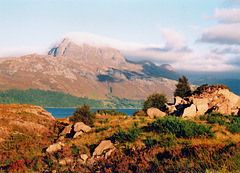Alan Drury's photos with the keyword: Scottish Mountains
A`Mhaighdean from Fionn Loch
| 22 Aug 2017 |
|
|
|
Emergency Shelter Ben Nevis Summit
| 22 Aug 2017 |
|
|
|
Steve & Alan at the Summit of Slioch 5th May 1995
| 22 Aug 2017 |
|
|
|
Slioch from Loch Maree,Ross-shire
| 22 Aug 2017 |
|
|
|
Ben Lomond & Loch Lomond
| 22 Aug 2017 |
|
|
|
Stob Dearg,Buachaille Etive Mor from The Coupall R…
| 09 Jan 2017 |
|
|
|
View down Glen Coe to Loch Achtriochtan 1st Novemb…
| 09 Jan 2017 |
|
|
|
Glen Coe (Scottish Gaelic: Gleann Comhann,pronounced [klan̪ˠˈkʰo.ən̪ˠ]) is a glen of volcanic origins, in the Highlands of Scotland. It lies in the north of Argyll, close to the border with Lochaber. It is often considered one of the most spectacular and beautiful places in Scotland, and is a part of the designated National Scenic Area of Ben Nevis and Glen Coe. The narrow glen shows a grim grandeur. The glen, approaching from the east on the main A82 road, is surrounded by wild and precipitous mountains. Further west at Invercoe, the landscape has a softer beauty before the main entrance to the glen. The main settlement is the nearby village of Glencoe located at the foot of the glen. near the site of the 1692 Massacre of Glencoe.
The Glen is named after the River Coe which runs through it. The name of the river is believed to predate the Gaelic language, and its meaning is not known. It is possible that the name stems from an individual personal name, Comhan (genitive Comhain).
Steve comming away from Am Bodach Ring of Steall.…
| 09 Jan 2017 |
|
|
Reflections of Loch Lochy
| 07 Jan 2017 |
|
|
|
Loch Lochy (Scottish Gaelic, Loch Lochaidh) is a large freshwater loch in Lochaber, Highland, Scotland. With a mean depth of 70 m (230 ft), it is the third-deepest loch of Scotland.
The Battle of the Shirts was fought at its northern end near Laggan in July 1544, between Clan Donald and Clan Fraser.
The Stand-off at the Fords of Arkaig in September 1665 ended a 360-year feud between the Camerons and the Chattan Confederation. It took place at Achnacarry, on the isthmus between Loch Lochy and Loch Arkaig.
Folklore tales mention 'a supernatural being' called the River Horse which was said to emerge from the lake and assume a horse's shape before feeding on the loch's banks. The River Horse was also known as the Lord Of The Lake and the Water King and would overturn boats and 'entice mares from their pastures'.Another tradition was that of the River Bull, 'a gentle, harmless creature', who would 'emerge from the lake into the pasture of cows'.
Laithach from Loch Clair Torridon
| 22 Dec 2016 |
|
|
|
Liathach is one of the most famous of the Torridon Hills. At a height of 3,461 feet (1,055 m), it lies to the north of the A896 road, in the Northwest Highlands of Scotland, and has two peaks of Munro status: Spidean a' Choire Lèith at the east of the main ridge, and Mullach an Rathain at the western end of the mountain. The name Liathach is pronounced [ˈʎiə.əx] in Scottish Gaelic, and means 'The grey one'. Liathach conveys an aura of impregnability when seen from the roadside below, as the slopes appear to rise up in a series of near vertical rocky terraces.
Lord Berkeley`s Seat, An Teallach 26th May 1999
| 21 Dec 2016 |
|
|
An Teallach is a mountain in Scotland. It lies to the southwest of Dundonnell and overlooks Little Loch Broom, in an area often nicknamed the "great wilderness". An Teallach means 'The Anvil' or 'The Forge' in Scottish Gaelic; although most scholars claim the latter is most correct as the mountain's name refers more to the colour of the terrain in certain lighting conditions, rather than shape.
The mountain is mostly made of Torridonian sandstone. Like the peaks around Torridon (for which the rock is named), An Teallach has terraced sides riven with steep gullies and a sharp rocky summit crest at Sgùrr Fiona. The steepest section, known as Corrag Bhuidhe, rises above Loch Toll an Lochain. Corrag Bhuidhe's most spectacular feature is an overhanging pinnacle known as Lord Berkeley's Seat.
Jump to top
RSS feed- Alan Drury's latest photos with "Scottish Mountains" - Photos
- ipernity © 2007-2025
- Help & Contact
|
Club news
|
About ipernity
|
History |
ipernity Club & Prices |
Guide of good conduct
Donate | Group guidelines | Privacy policy | Terms of use | Statutes | In memoria -
Facebook
Twitter











